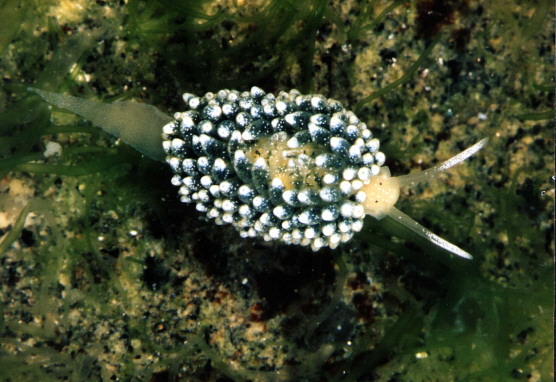 |
Stiliger sp.
Photo courtesy of Dr. Wes Farmer
Stiliger sp.
Mike Miller (Webmaster) asked me for a photo of a branch for his web site. I suggested an
animal discovered upon Codium magnum in Bahia San Quintin, Baja California. Mr. Jim R.
Lance vocalized it to be "Stiliger farmeri". So why not share this
discovery with you folks. There is a bit of history however to this algae.
It goes back to the late 1950’s when Dr. Yale Dawson (an algae expert )and my
self were exploring the area before any paved roads were into the area. Both
exploring independently of each other. Dr. Dawson collected some of the
Codium magnum and described it in the Torrey Pines Botanical Society
Newsletter. He also placed in the San Diego Natural History Museum, two
herbarium mounts of the algae. Only later to be discovered when looking for
a name for this very large (to 15-20 feet long) algae. Indeed there are two
morphs or two different species living side by side.
The habitat for the Stiliger discovered when Mr. James R. Lance and my self visited the area in 1996 looking for Vacheria algae and the small opisthobranchs feeding on same. We did find the matted algae and the opisthobranch. While searching east of Petregal in the very deep mud flats looking for opisthobranchs, we came upon a small piece of Codium, Jim looking from one side the rock and myself from the other. I picked up what appeared to be a green aeolid with many cerata, the only one found on the trip.
Jim identified it as a new kind of Stiliger. The next trip to the area was by my self to look for the biomass of Codium and indeed found it to the South of Pedregal. Also noted two morphs of the algae. This area produced additional specimens incuding a large number of breeding Elysia hedgpethi.
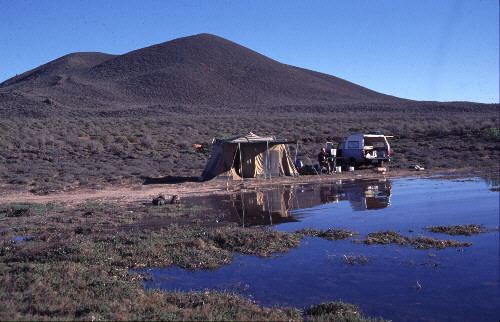
| The next trip with Jim Lance was to locate the greatest biomass of Codium to thereby discover breeding Stiliger and Elysia. The tide was over 7 feet and we had to move the tent because the advancing tide did not seem to stop. The dirt road was under water and the tide advanced to the camp site inch by inch and at the front door stopped and the damp earth marked the turning point of the tide. Jim collected a lot of data for the critter. Other trips to the area noted that the December seemed to be the time when Codium had the most biomass and in the summer the least if any. |
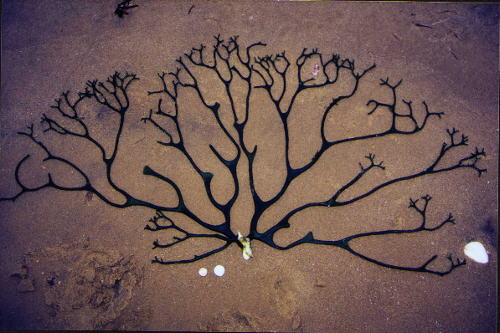
| There are two morphs of this algae one a foot or so tall and very dense, the other 15-20 feet long and varying broad nodes at the bifurcation’s. The smaller on is not Codium fragile in my estimation it simply does not look like it. Could they be sexually separate parts of the same plant? Any way my strength is not in botany. The Old Grist Mill area with the swift flowing water also has a population of the two morphs of the Codium magnum and the Stiliger |
. The Stiliger "farmeri" (Lance Personal Communication) is on the order of 15 mm and may have 200 green white tipped cerata. The head may be green or cream color. The cephalic tentacles are nearly half and half green and cream distally. The tail is very pointed. When feeding on the algae they may do it in teams all head first into the green plant tissue. One can not see how many are at their meal. Afterward the upper layer of cells are missing and a depression seen where they had their fill.
It has been several years since the day that first one was discovered (on the ebb tide a few days prior to 15 April, 1996. Mr. Lance is working on this aspect of the report and publication in greater detail.
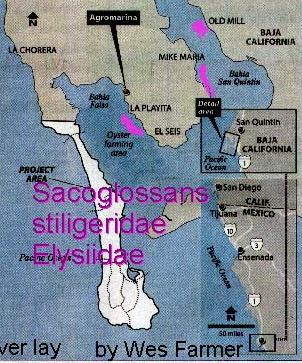
| There are plans to develop San Quintin bay and harbor. Should this happen the fate of this unique Codium magnum habitat might very well be in danger of being lost to nature. Wouldn’t it be great to preserve this section of beach south of Petregal? It is also an important marine fossil area. Created by the black flowing lava and cinders from the erupting cinder cone so many eons ago. Why this algae ecosystem was overlooked is beyond me. Since so many research scientists from many countries including Mexico have studied this bay, this oversight remains a mystery to me. |
One last note. It is mentioned that no new species of opisthobranch be
published on the web prior to paper printing. I’d like to point out that
during the middle of October 1999 from Madagascar a jaw bone and teeth of
what is believed to be the oldest dinosaur was placed as news on the web.
It even commented that it is not named yet only speculation. However we see
the image of the jaw bone and the teeth and know where it came from. Later
someone will put a name to it. Fair enough?
21 October, 1999
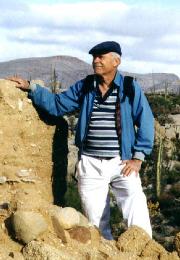
| Wes shown doing what he likes to do best, exploring the outback attempting to understand nature's many mysteries! The Webmaster is indebted to Wes for taking the time to put together this BOW on such short notice. Wes still has copies of SEA-SLUG GASTROPODS available. The book has
157 species of sea slugs occurring from Panama to Alaska. The book was published in 1980 and the names are of that time. The book sells for
$17.50 includes postage and handling. Send Wes email at wmfarmer@adnc.com |
